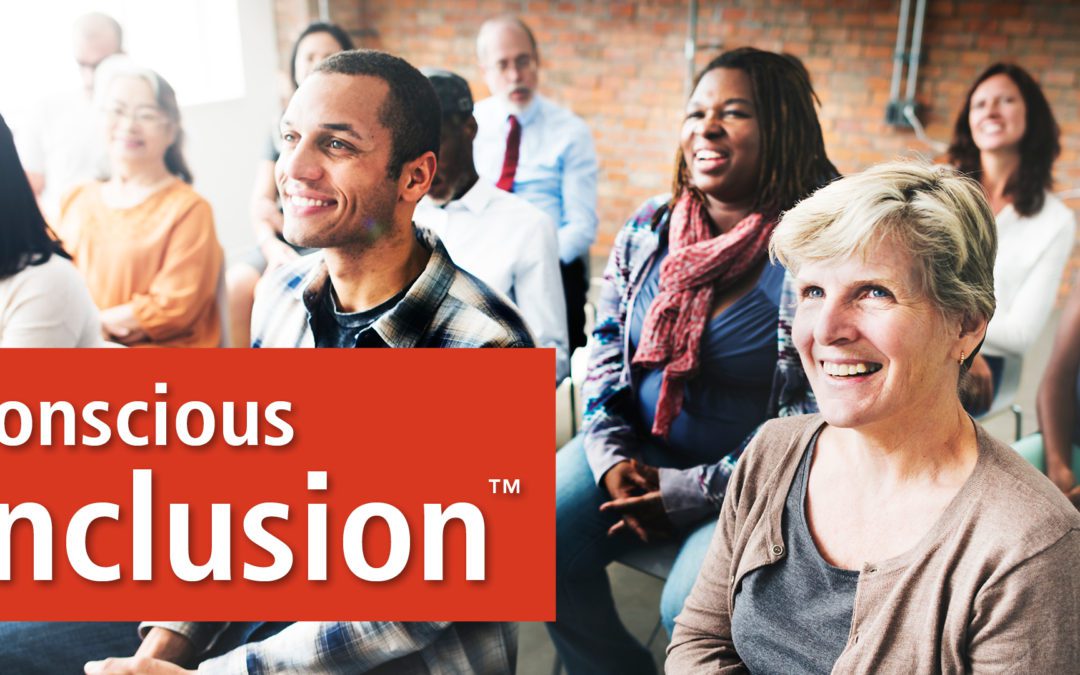Introduction to Inclusive Leadership
Training to build the foundation of a diverse, innovative, and productive workplace culture.Today’s leaders must be able to effectively communicate and build trusting work relationships with many different kinds of people. We are moving from the era of “command and control” to an era of “engage and include.”

Some individuals have a natural ability to feel comfortable with many different types of people and can easily build camaraderie within their teams. Others are comfortable exhibiting inclusive behaviors themselves but have difficulty coaching and developing these skills among those who report to them. And still others have difficulty establishing comfortable working relationships with specific people or groups.
According to the Gallup Organization, disengaged (exclusive) managers are three times
more likely to have disengaged and actively disengaged employees, costing businesses
billions of dollars in lost revenue each year. If you are working to create a culture that values all employees and is inclusive of differences, your leaders must understand what inclusion is, how it is achieved and what specific behaviors and actions they can take to promote the culture you desire.
Inclusity’s Introduction to Inclusive Leadership Workshop (or series) provides your supervisors, managers, and leaders the personal insight and awareness, knowledge and skills they need to become the best and most inclusive leader possible.
In this four-, eight-, or 12-hour workshop (or series of shorter workshops if desired) we introduce your leaders to up to four Inclusity Models and the tools they need to actively become inclusive leaders.
Learning Objectives:
- Participate in and lead small group discussions about the factors that define their team members, in order to build trust and open communications
- Understand the attitudes and behaviors that create exclusion
- Identify situations in which team members are being excluded
- Increase their commitment to actively include instead of unintentionally excluding
- Utilize models presented during the training to intentionally create more inclusive workplace teams
From The Inclusity Blog

How to Leverage Trust In Leadership to Strengthen Inclusion
Why is Trust in Leadership important?
Diversity and inclusion have been more of a focus the last few years, but an organizational commitment to promote a diverse and inclusive culture is predicated by a climate of trust – especially trust in leadership. “For many years, it’s been about having diversity represented. The way to get from diversity to inclusion is to build trust along the way,” says Tina Jaynes, Executive Vice President of Inclusity. “Trust is a foundational piece to get us from diversity to inclusion, and without an environment of trust, diversity can’t thrive.”
Every organization wants its employees to feel empowered to bring their authentic selves to work. Fostering trust and trust in leadership are key to provide that sense of safety so people can be authentic. When we feel safe, we feel comfortable to open up and expose vulnerabilities. Without trust and psychological safety, employees will struggle to talk about key issues like bias and race in their organizations. But trust doesn’t just happen – you have to earn it! Knowing is only half the battle; leaders must work on themselves, their behaviors and actions to create a culture of trust amongst employees and the workplace in general.
We put a short list of behaviors that leaders can focus on to begin the process of building trust in leadership. Adopting these characteristics can help foster a culture of trust and achieve inclusion, diversity, and equity (IDE) goals, and start you and your company on the path to becoming a more inclusive workplace.
How to Leverage Trust in Leadership to Strengthen Inclusion
Be Vulnerable: Being vulnerable doesn’t imply weakness, over-sharing, or violating professional boundaries. It means being open to potential criticism, trying something new and making a mistake, or allowing your approach to be questioned.
Be Authentic: To be authentic means that you are truly showing up as yourself. Being authentic creates psychological safety in the workplace. People tend to trust you when they believe they are interacting with the real you, and are more likely to feel safe enough to be their own authentic self, allowing them to express thoughts and feelings that can be new and exciting!
Be Courageous: In a trusting work environment, you need to have the courage to share your flaws and accept the flaws of others without judgment. Courage is inspiring – there’s a reason so many books, movies and stories are based on courage. By being courageous and practicing courageous inclusion, you can create a culture that many employees dream of.
Be Empathetic: Empathy, the ability to imagine what someone else might be thinking or feeling, is an indispensable skill needed to build trust with employees. The key to empathetic leadership is being willing to understand how another person may experience an event or situation without passing judgment or making assumptions, allowing them to feel safe and understood.
Be Curious: Being curious is foundational to creating an environment where people feel valued and really believe that you have a true interest in them and their point of view. Curiosity is one of the most important foundational behaviors of inclusive leaders; it leads to connection, innovation and creating a sense of belonging not just in the workplace, but in life itself.
If you’re intentional about building it, trust can blossom into authentic relationships and a deeper embrace of diverse, inclusive, and equitable workplaces. As we’ve mentioned before, however, any change in culture must start at the top. That’s why trust in leadership is so important; we must lead by example to create the environment we wish to see. Learn more about our inclusion practice, which can help you foster greater psychological safety and trust in your organization.

Why Inclusion Comes First: 5 way to Lead with Inclusion
Why Inclusion Comes First
The approach to diversity in our workplaces is constantly changing. While there are various acronyms for this work (DEI, EDI, I&D, EDIB), at Inclusity, we think that inclusion matters most. We believe this so strongly that we’re steadily shifting from DEI to use the acronym IDE, which places inclusion first. Making sure that Inclusion comes first forms a a strong foundation for a company’s culture, employee engagement, sense of belonging, and recruitment and retention efforts.
Inclusion Leads to Diversity
Over the years, a lot of emphasis has been placed on diversity with the assumption that inclusion will follow. However, once you bring diverse individuals on board, what is their experience of the workplace culture? If it’s not an inclusive workplace, diversity and belonging just won’t thrive. This is why inclusion comes first, or at least why it should.
Diversity refers to the traits and characteristics that make people unique while inclusion refers to the behaviors that ensure people feel welcome. Inclusion is the conscious effort to support diversity. To sustain a diverse workforce, people have to be taught how to manage, lead, operate, and hire in an inclusive way, which creates an environment in which everyone feels comfortable to be themselves. If you get this right, you’ll naturally attract diverse talent.
Belonging Follows Inclusion
Let’s introduce another letter to the IDE framework – B for “Belonging.” It’s a goal of IDE efforts that people feel a sense belonging. It means people feel the psychological safety to bring their authentic selves to work and truly feel a part of something. Before employees can feel emotionally safe and accepted, there must be a level of inclusion so they’re not facing microaggressions, unconscious bias, and other forms of exclusion. Creating genuine feelings of belonging is a critical factor in improving engagement and performance. And making sure inclusion comes first will help diverse employees feel like they belong!
“Organizations should focus on becoming intentionally inclusive – learning what behaviors lead to intentional inclusion,” Maria White, CEO and founder of Inclusity, shares. “Then, once they achieve that, they can set the course toward becoming a culture of belonging.”
Focus on Inclusion
Following are five ways to make sure inclusion comes first:
Integrate inclusivity into your core values. Including inclusivity in your core values sets the tone for an inclusive company culture. It signals to both new hires and current employees the expectations surrounding diversity and acceptance within the business.
Create an inclusive workplace taskforce. Create a team of people who are knowledgeable on the topic of inclusion and have a passion for it. Encourage the team to come up with strategies that can be implemented throughout your organization.
Assess the culture regularly and take action to address concerns. Confidential surveys, focus groups, and informal discussions can help identify concerns about the workplace climate and potential solutions. Employers should ensure that a diverse cross-section of the workforce is involved in identifying problems and potential solutions.
Expect leaders and managers to participate in behavior-based inclusion training. In addition to increasing awareness, IDE workshops will have the most impact if they are behavior-based. People need to be taught how to engage in the types of behaviors that organizations would like to see.
Practice inclusive leadership. Leaders need to create a safe team environment where all employees can speak up, be heard, and feel welcome. They should embrace the input of employees whose backgrounds differ from their own, foster collaboration among diverse staff, ask questions of all members of the team, facilitate difficult conversations, and give actionable feedback.
An inclusive culture and making sure inclusion comes first is one of the best ways to create and maintain a healthy and diverse workplace that gives employees safe spaces where they can feel comfortable bringing their authentic selves to work. Pave the way for true cultural transformation by making inclusion a sustainable part of your organization. To learn more about how to put inclusion and diversity into action, explore our services.

Beyond Pride Month: Establishing an LGBTQ+ Inclusive Workplace
Every June, businesses celebrate Pride Month to show their support for the LGBTQ+ community; however, true allyship requires advocacy beyond one month a year. The LGBTQ+ community and its allies need businesses to activate beyond Pride Month and stand behind the community year-round. Corporate America can demonstrate their true commitment through actively working to reduce workplace discrimination and supporting employees who identify as LGBTQ+ in the workplace.
Internationally recognized events like Pride Month should remind us of the importance of fostering fully inclusive workplaces. Instead, many companies fall prey to the phenomenon of “rainbow washing,” which is when businesses align themselves with Pride for personal gain, rather than to genuinely support the LGBTQ+ community. Examples of rainbow washing include public gestures of support such as corporate groups marching in parades, corporations adding rainbow colors to their logos, changing social media avatars, publishing support statements at the start of Pride Month, and using a rainbow to push products — all without the benefits of an LGBTQ+ inclusive workplace. For example, one Fortune 500 corporation updated its Instagram profile picture to include a pride flag despite donating nearly $1 million to anti-gay politicians.
Creating a genuinely inclusive culture means taking year-round action. How can businesses or organizations celebrate and support LGBTQ+ employees beyond Pride Month? There are ways to give more meaningful support to the LGBTQ+ community through intentional and concerted effort to build an equitable and inclusive workplace. The suggestions below promote LGBTQ+ representation and equality in the workplace through actionable steps:
-
1. Policies Should Be the Starting Point
Set and enforce policies to protect LGBTQ+ employees such as non-discrimination (including sexual orientation, sexuality, and gender identify) and anti-harassment policies to ensure workplaces are free of discrimination and subtle acts of exclusion (microaggressions).
-
2. Offer Inclusion Training
Provide diversity and inclusion training that addresses sexual orientation and gender identity, formal LGBTQ+ awareness training programs, as well as inclusive management training.
-
3. Commit to Inclusive Hiring Practices
Level the playing field for all candidates with practices including inclusive job descriptions, bias awareness training for hiring teams, and diverse interview teams.
-
4. Promote Formal LGBTQ+ Allyship
Allies are influential colleagues who openly champion and support LGBTQ-inclusive policies and employees. Allyship can take many forms, including implementing programs like Culture Champions, which provide participants the skills and tools to role model and foster inclusion.
-
5. Support Employees with Climate Surveys
Conduct research to better understand the culture for employees who identify as LGBTQ+. The purpose of the research is to identify issues and concerns that impact the organization’s ability to have a welcoming and inclusive environment.
-
6. Expand Benefits
LGBTQ+ employees often face disparities in access to healthcare and benefits such as parental leave. Offer paid family leave to include LGBTQ+ employees and same-sex benefits. Gender affirming health care benefits allow gender-diverse people to maximize their overall health and psychological well-being.
-
7. Establish an LGBTQ+ Employee Resource Group
Promote inclusivity and belonging through an LGBTQ+ ERG. An employee-led affinity group addresses the unique needs of the community and improves the working environment for hiring, retaining, and advancing LGBTQ+ employees.
-
8. Support Events Beyond Pride Month
Engaging with the LGBTQ+ community beyond obvious events, such as Spirit Day, can send a strong message about a business’ commitment to diversity.
Supporting LGBTQ+ employees can look different from company to company, but the main goal is that every employee feels supported and valued. Employers have a responsibility to make sure all employees feel seen and supported in bringing their true and authentic selves in the workplace. If your company is interested in talking with Inclusity to ensure that you’re providing a truly inclusive work environment for all employees, we’re here to help.

Rules of Engagement: 5 Ways to Increase Employee Engagment
It’s Time to Focus on Employee Engagement
The studies are clear. Employee engagement affects business performance, and job satisfaction. But what does engagement mean and how do you drive it in the workplace?
Simply put, engagement is the connection employees feel with their organization. With decades of research on this topic, Gallup defines employee engagement as the involvement and enthusiasm that employees have in both their work and workplace. Various factors contribute to engagement, including professional development opportunities, employee wellness programs, strong relationships with colleagues, and a supportive environment in which they are valued. An inclusive, diverse culture is the foundation for high employee engagement.
When organizations capitalize on the strengths and unique value of their employees, they create a work environment where employees are truly engaged. If individuals cannot be their authentic selves at work, they won’t be as engaged and are more likely to leave, report Kenji Yoshino and Christie Smith in their book Uncovering Talent: A New Model of Inclusion. A company’s ability to attract a highly diverse workforce and build a truly inclusive culture result in increased employee engagement, reduced employee turnover, improved productivity, and greater profits. In today’s climate, companies must take proactive steps to increase employee engagement or risk losing their workforce.
How can your organization nurture an inclusive culture, creating positive employee experiences and a workplace where employees feel safe to bring their whole selves to work? Here are some options to explore:
Employee Resource Groups
Encourage and fund employee resource groups (ERGs) that represent diverse identities. An ERG group is comprised of employees with a shared background, experience, or interest, such as ethnicity, gender, or parenting. Each group builds a strong sense of belonging and community and offers a safe space for open discussions. ERG programs advance a respectful and inclusive company culture and provide both personal and professional support to participants.
Work-Life Balance Programs
The goal of work-life programs is to enhance the workplace for an increasingly diverse workforce. This could mean providing flexible working hours or options that support families, like childcare. Work-life balance means acknowledging that each employee is a whole person, with personal factors and experiences that affect their work. Supporting their needs is important for making the workplace inclusive — and that leads to greater engagement.
Mentorship and Sponsorship
We know that mentoring matters for professional advancement. For employees in marginalized groups, it’s even more critical. To ensure their inclusion, proactive sponsorship is necessary. Mentors and coaches can help mentees improve both ther hard skills that are important to productivity and soft skills that create a more inclusive and dynamic work environment.
As Rosalind Chow writes in a Harvard Business Review article, “Allies need to not only offer the emotional support of mentoring but also be intentional about identifying opportunities for sponsorship and using our social capital to lift up those who might otherwise go unnoticed.”
Inclusion Training
Providing learning opportunities to all employees can offer more than professional growth. Interactive training that delves into diversity and inclusion like overcoming biases and identifying micro aggressions enhances employees’ awareness and skills. These types of workshops are important building blocks for creating an inclusive, engaged workplace.
Celebrate holidays and events
Diversity initiatives for underrepresented cultures and backgrounds like Black History Month, Chinese New Year, and Pride Week are a valuable way to help every employee feel represented at work. Celebrating and learning about each other’s customs and traditions fosters a culture of inclusion that makes employees feel recognized and valued.
If you’re looking to drive employee engagement, start with inclusion and embrace diversity. And if you’re looking to understand just how to do that, contact us here.

Don’t Miss a Connection
Inclusity starts each inclusion training session with a “connection.” This is more than just a euphemism for those (sometimes-corny) ice breaker activities that add levity to a workshop, if little substance.
Often our connection exercises ask participants to introspect (to connect with themselves, if you will). Then comes the sharing and listening to each other, which is where the real connections start to be forged. We reveal our humanness, acknowledge our diversity, and, most importantly, realize our similarities — where we connect.
“We connect people first, as opposed to focusing on differences first,” says Maria Arcocha White, CEO and founder of Inclusity. “We start the conversation around what is common for them; that builds trust, that enables conversation, and that facilitates communication.”
In an increasingly disconnected world (in spite of the ubiquity of technological connections), these in-person activities are vital.
“Connection is important,” writes Ken and Scott Blanchard in Fast Company. “People who feel connected to their leader are more likely to feel good about their jobs, stay with the organization, and act in ways that support it. Without connection, people feel out of the loop. This leads to isolation, a lack of well-being, and possible disengagement.”
Inclusity fosters connections to deepen people’s awareness and build foundations for inclusive cultures. “Our approach brings people together, and then once we bring them together, it’s way easier to talk about the differences,” says Arcocha White. “Ninety-eight percent of people on this earth are well-intentioned, good-hearted people who want to have good relationships and want to be successful in the workplace. But they just don’t know how to deal with difference effectively.”
She adds: “When people feel heard, valued and that they belong, they engage and contribute to their maximum potential.”
People can experience Inclusity’s positive approach to inclusion and diversity training at a Conscious Inclusion workshop. The three-hour workshop’s discussions and interactive activities help participants understand and recognize unconscious bias and how it affects culture and business productivity. Participants will then learn practical tips to be more intentionally inclusive.
It “opened eyes to things happening everyday, and now I feel in a better place to handle them,” one past participant shared. Another commented: “I have attended many diversity and inclusion workshops, and this was by far the most engaging and beneficial.”
Inclusity facilitates Conscious Inclusion workshops at businesses and organizations across the country. Talk to us if this sounds like it might be a good fit for your organization or if another inclusion and diversity training program could work for you. We’re holding a public Conscious Inclusion workshop in Indianapolis on Oct. 15 from 9 a.m. to noon, if you are interested in participating, click here or call 317-716-7678.
